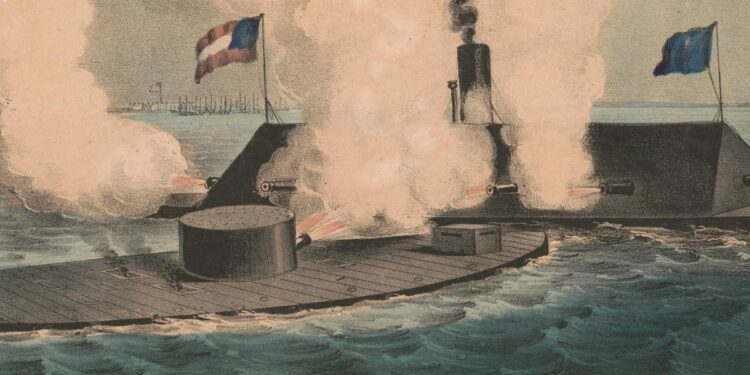The Battle of the Monitor and Merrimack, also known as the Battle of Hampton Roads, marked a historic turning point in naval warfare during the American Civil War. Fought on March 8 and 9, 1862, this clash between two ironclad warships, the USS Monitor and the CSS Virginia (formerly the USS Merrimack), revolutionized naval design and tactics.
The Confederate Navy had converted the scuttled USS Merrimack, a wooden frigate, into the ironclad CSS Virginia. On March 8, 1862, the Virginia made its debut, wreaking havoc on the Union’s wooden warships in Hampton Roads, Virginia. The Union, desperate to counter this formidable threat, deployed the innovative USS Monitor, an ironclad designed by Swedish engineer John Ericsson.
The Monitor featured a revolving turret housing two massive cannons, a design that deviated from traditional warship configurations. This departure marked a radical shift in naval architecture, introducing a new era of ironclad vessels. The confrontation between the Monitor and the Virginia showcased the effectiveness of these iron behemoths and their impact on the future of naval warfare.
The Battle of Hampton Roads on March 9, 1862, was a dramatic clash between these ironclad titans. The Monitor and the Virginia engaged in a historic duel, each attempting to gain the upper hand. The battle ended in a tactical stalemate, as neither side could decisively defeat the other. Despite the inconclusive outcome, the significance of the battle lay in the proof that ironclads were the future of naval warfare.
The engagement highlighted the strengths and weaknesses of ironclad ships. The iron armor provided unprecedented protection against traditional wooden warships, rendering them obsolete. However, the battle also revealed the limitations of these early ironclads, such as their vulnerability to mines and torpedoes.
The Battle of the Monitor and Merrimack had profound implications for naval strategy and ship design. The concept of wooden navies was rapidly becoming obsolete, and major naval powers worldwide started investing in ironclad fleets. The Monitor and the Virginia set the stage for the development of modern naval vessels, influencing the designs of future warships.
In conclusion, the Battle of the Monitor and Merrimack was a pivotal moment in naval history, showcasing the dawn of a new era in warfare. The clash between these ironclad warships laid the foundation for the evolution of naval technology and tactics, leaving an indelible mark on the course of naval warfare for years to come.



Recent Comments